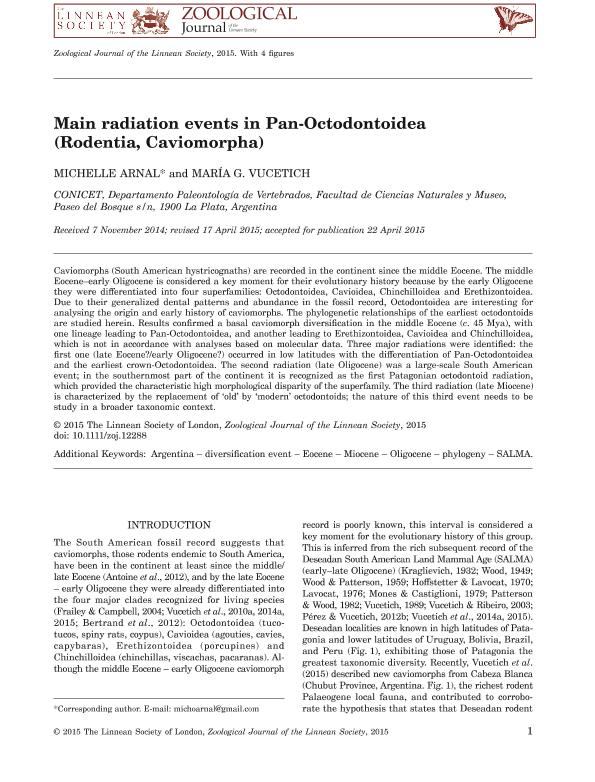Artículo
Main radiation events in Pan-Octodontoidea (Rodentia, Caviomorpha)
Fecha de publicación:
11/2015
Editorial:
Wiley Blackwell Publishing, Inc
Revista:
Zoological Journal of the Linnean Society
ISSN:
0024-4082
Idioma:
Inglés
Tipo de recurso:
Artículo publicado
Clasificación temática:
Resumen
Caviomorphs (South American hystricognaths) are recorded in the continent since the middle Eocene. The middle Eocene-early Oligocene is considered a key moment for their evolutionary history because by the early Oligocene they were differentiated into four superfamilies: Octodontoidea, Cavioidea, Chinchilloidea and Erethizontoidea. Due to their generalized dental patterns and abundance in the fossil record, Octodontoidea are interesting for analysing the origin and early history of caviomorphs. The phylogenetic relationships of the earliest octodontoids are studied herein. Results confirmed a basal caviomorph diversification in the middle Eocene (c. 45 Mya), with one lineage leading to Pan-Octodontoidea, and another leading to Erethizontoidea, Cavioidea and Chinchilloidea, which is not in accordance with analyses based on molecular data. Three major radiations were identified: the first one (late Eocene?/early Oligocene?) occurred in low latitudes with the differentiation of Pan-Octodontoidea and the earliest crown-Octodontoidea. The second radiation (late Oligocene) was a large-scale South American event; in the southernmost part of the continent it is recognized as the first Patagonian octodontoid radiation, which provided the characteristic high morphological disparity of the superfamily. The third radiation (late Miocene) is characterized by the replacement of 'old' by 'modern' octodontoids; the nature of this third event needs to be study in a broader taxonomic context.
Archivos asociados
Licencia
Identificadores
Colecciones
Articulos(CCT - LA PLATA)
Articulos de CTRO.CIENTIFICO TECNOL.CONICET - LA PLATA
Articulos de CTRO.CIENTIFICO TECNOL.CONICET - LA PLATA
Citación
Arnal, Michelle; Vucetich, María Guiomar; Main radiation events in Pan-Octodontoidea (Rodentia, Caviomorpha); Wiley Blackwell Publishing, Inc; Zoological Journal of the Linnean Society; 175; 3; 11-2015; 587-606
Compartir
Altmétricas




